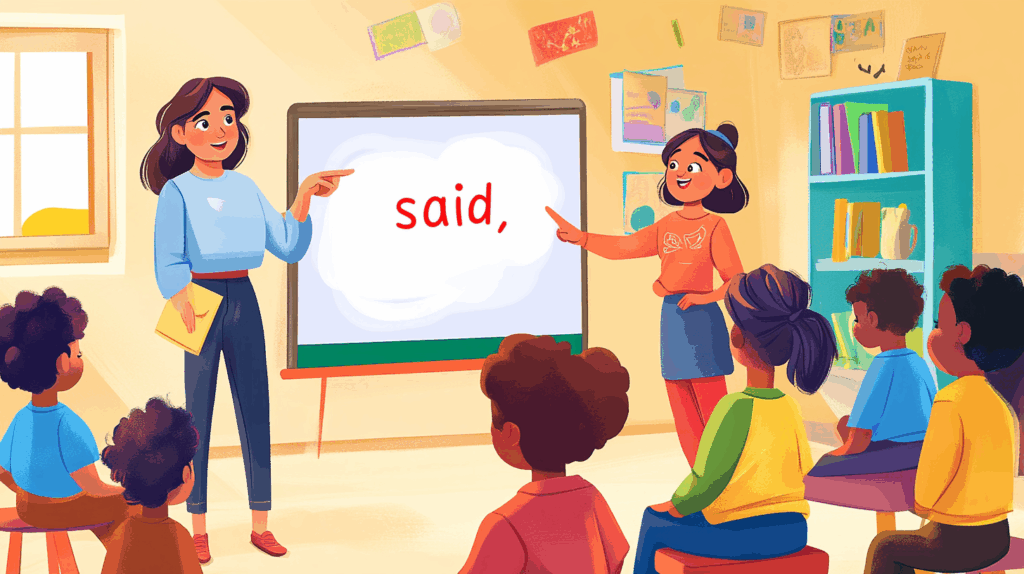Ever wonder why some words don’t make sense when your child tries to read them? It can be frustrating for both of you.
Heart Word Magic offers a simple solution by breaking down these difficult words into regular parts and “heart parts” that need special attention.
This free tool makes kids learn sight words by focusing on the specific sounds that break the rules.
Throughout the blog, you’ll learn practical ways to use Heart Word Magic in classrooms and homes and effective techniques for pairing it with other reading tools.
Ready to help your child master those puzzling words that make reading so difficult? Learn how to avoid common teaching mistakes with Heart Word Magic.
What is Heart Word Magic?
Heart Word Magic is a free tool that helps kids learn tricky sight words. It focuses on sounds and spelling patterns that don’t follow the rules. Teachers and parents use it to make reading easier and more fun.
A Simple Definition
Heart Word Magic is a teaching tool for high-frequency words like “said,” “was,” and “they” that don’t follow regular spelling patterns.
It works by having children identify which parts of a word follow phonics rules and which “heart parts” need to be memorized.
For example, in “said,” the “s” and “d” follow regular patterns, but “ai” makes an unexpected short “e” sound. By marking these different parts, kids learn tricky words more easily.
Why it Works
Heart Word Magic connects to the Science of Reading through orthographic mapping, which shows how our brains link speech sounds to written letters to create word memories.
While regular words can be sounded out with phonics, common words often have odd spellings.
This method helps children store these words in memory by clearly showing which parts follow rules and which need special attention.
This approach is more effective than memorizing whole words because it builds both phonics skills and sight recognition.
It helps children understand English spelling patterns while learning the exceptions they’ll need for fluent reading.
Heart Word Magic: Learning Words Creatively

This method uses fun videos and clear visuals to teach words with irregular spellings. It helps kids remember tricky words by focusing on the part that’s “from the heart.”
Learning becomes more engaging through sound, movement, and creative memory tricks.
Step-by-Step Teaching Method
Heart Word Magic changes word learning by splitting challenging words into two critical components.
Students focus on heart words – tricky spellings requiring special memorization – and decodable parts following standard phonetic rules.
This approach helps learners understand word structures more effectively and builds confidence in reading and spelling skills.
The word “said” perfectly demonstrates Heart Word Magic. The “ai” section becomes a heart word, requiring unique memorization strategies.
Students learn to recognize this unusual spelling through targeted practice and visual memory techniques.
The surrounding letters “s” and “d” can be decoded using traditional phonetic approaches, making the learning process more manageable.
Visual and Audio Support
Multimedia techniques change word learning into an engaging experience. Video lessons use colorful animations and interactive graphics to illustrate spelling patterns.
Audio components, including rhythmic chants and pronunciation guides, help students internalize challenging words.
These multi-sensory approaches accommodate different learning styles and make language acquisition more enjoyable.
Heart Word Magic: Word List and Examples
Heart Word Magic covers many common sight words like “said,” “what,” and “does.” These words don’t follow regular phonics rules.
This section includes sample words and explains why they’re tricky, along with how the tool helps students master them.
Common Heart Words
Beginner level words:
- said
- was
- of
- to
- do
- some
- come
- have
Intermediate level words:
- because
- friend
- people
- could
- would
- should
- their
- there
Advanced Level Words:
- beautiful
- again
- laugh
- through
- though
- weight
Tricky vs. Regular Words
Heart Word Magic zeros in on words with complex phonological relationships that challenge traditional reading strategies.
Regular words follow predictable spelling patterns, allowing students to sound them out easily. In contrast, tricky words contain spelling combinations that don’t match standard sound rules.
Understanding Phonological Challenges
Some words in English have spelling patterns that confuse young readers. For example, “said” sounds different from how it looks.
The “ai” combination doesn’t follow typical pronunciation rules. Similarly, words like “could” and “would” have silent letters that make them difficult to decode using a standard phonetic approach.
How to Properly Use Heart Word Magic
You can use Heart Word Magic in the classroom or at home. Just play a short video, discuss the sounds, and have kids repeat the word. It’s great for daily practice, small groups, or extra reading support.
Using Heart Words in the Classroom
Heart Words (also known as sight words or high-frequency words) are essential building blocks for reading fluency. In the classroom, integrate these words through consistent exposure and practice.
Daily routines create natural opportunities for Heart-Word learning. Begin each morning with a quick 3-5 minute review using flashcards, pocket charts, or interactive whiteboards.
Keep the pace lively and energetic. During transitions between activities, ask students to read the displayed Heart Words before lining up or moving to the next center.
Small groups provide targeted instruction. Work with 4-6 students at similar reading levels, focusing on specific Heart Words they’re ready to master.
Use multi-sensory approaches; students can trace words in sand, build them with magnetic letters, or form them with play-dough. These tactile experiences strengthen memory pathways.
Interventions help struggling readers catch up. Schedule short, frequent sessions focused exclusively on Heart Words.
Work one-on-one or in pairs, using games that provide repeated exposure. Track progress visually with charts or graphs so students can see their growth.
Remember to celebrate every success, no matter how small.
Using Heart Words at Home
Parents and homeschoolers can reinforce Heart Word recognition through everyday activities.
Label household items with their corresponding words to turn your home into a word-rich environment. The refrigerator, door, and table become familiar sight word anchors.
Meal preparation offers natural learning moments.
Ask your child to read recipe words like “mix,” “cup,” or “add” as you cook together. This connects Heart Words to practical, enjoyable experiences.
Change daily reading time by hunting for Heart Words in books. Before reading a story, choose 2-3 target words to find.
When your child spots one, they can place a small sticker or token on the word. This simple game maintains engagement while building recognition skills.
With portable Heart Word cards, car rides and waiting times become learning opportunities. Keep a small set in your purse or car console for quick practice during otherwise idle moments.
Remember that consistency matters more than duration. Five minutes of focused practice daily yields better results than occasional longer sessions.
Keep the tone playful and positive, ensuring that Heart Word learning feels like a special time rather than a chore.
Tips for Getting the Most Out of Heart Word Magic
To get the best results, use Heart Word Magic regularly and talk about the tricky parts of each word. Pair it with phonics lessons.
Keep things fun and simple. Use printables and videos together to help kids stay interested and remember more.
Pairing with Other Phonics Tools
- Combine with explicit phonics teaching to help students understand both decodable and irregular parts of words.
- Pair with phonemic awareness activities like sound manipulation games
- Use text reading with high concentrations of target words for authentic practice
- Incorporate writing activities that use Heart Words in sentences
- Maintain personal word banks where students collect mastered words
Avoiding Common Mistakes
- Don’t rely solely on memorization—teach students to analyze word patterns
- Include a systematic review to prevent forgetting previously taught words
- Connect Heart Word instruction to other subjects instead of teaching in isolation
- Introduce only 3-5 new words weekly rather than overwhelming students
- Use assessment to track mastery and identify students who need extra support
- Avoid drilling without context—make practice meaningful
- Remember that consistency matters more than duration for effective learning.
Wrapping Up
Heart Word Magic changes the way children learn challenging words that don’t follow regular spelling patterns.
By separating words into regular phonics parts and special “heart parts,” children develop stronger reading skills more quickly.
Using Heart Word Magic in small daily doses, whether through classroom activities or home practice, builds lasting word recognition.
The key is consistency, focused practice, and keeping the Heart Word Magic experience fun.
When combined with other phonics tools and careful attention to common teaching mistakes, Heart Word Magic becomes even more powerful.
Want to support stronger reading skills? Explore more tools and tips to make learning sight words easier and more fun for every child.




